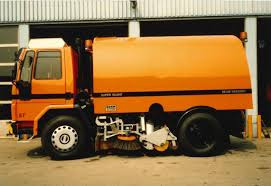Gothenburg, Sweden, Studies Street Sweeping Pollutant Removal
by Ranger Kidwell-Ross
The study appears to have been conducted in 2018 but not learned about, and reported on here, until late 2024.
Gothenburg is the 2nd largest city in Sweden, after the capital, Stockholm, and the 5th largest city in the Nordic countries. It has about 1.1 million inhabitants in its metropolitan area.
The study on street sweeping the City conducted emphasized the amount of pollutants retained in the water used for dust suppression while sweeping and discussed the importance of properly disposing of it.
 The story below is a narrative version of the sweeping study, followed by the key findings from the study on organic pollutants in street sweeping materials. The study itself noted that a vacuum-type sweeper was used for the study.
The story below is a narrative version of the sweeping study, followed by the key findings from the study on organic pollutants in street sweeping materials. The study itself noted that a vacuum-type sweeper was used for the study.
On a crisp autumn morning in Gothenburg, Sweden, a Johnston Beam street sweeper rumbled down the urban roads, collecting dust and debris as it went. Little did the operator know, but inside that machine was a complex mixture of microscopic particles and chemical compounds that would soon reveal important insights about urban pollution.
Back at the laboratory, researchers eagerly analyzed samples from the street sweeper's collection. As they peered through microscopes and ran chemical tests, a fascinating story began to emerge. Tiny nanoparticles, some less than 1 nanometer in size, were found floating in the washwater used by the sweeper. These minuscule particles ranged from 25 to 300 nanometers – so small they could potentially pass through biological membranes.
 But it wasn't just the size of the particles that was noteworthy. The scientists discovered alarmingly high levels of pollutants clinging to them. Aliphatic hydrocarbons and polycyclic aromatic hydrocarbons (PAHs) were present in extreme concentrations, especially in samples collected after the winter when no sweeping had occurred for months.
But it wasn't just the size of the particles that was noteworthy. The scientists discovered alarmingly high levels of pollutants clinging to them. Aliphatic hydrocarbons and polycyclic aromatic hydrocarbons (PAHs) were present in extreme concentrations, especially in samples collected after the winter when no sweeping had occurred for months.
As they dug deeper, comparing road dust, washwater and stormwater samples, patterns emerged. Many of the pollutants seemed to preferentially attach to the smallest particles with high organic content. The washwater from the sweeper contained the highest pollutant levels, while the larger road dust particles were relatively cleaner.
The researchers realized the street sweeper was doing more than just cleaning the roads – it was collecting a concentrated cocktail of urban pollutants that would require careful handling and treatment. Their findings highlighted both the value of street sweeping for improving stormwater quality, but also the need for proper management of the collected waste to prevent these pollutants from harming the environment.
As they compiled their results, the scientists knew their work could have important implications for urban pollution control. The analysis of the street sweeping process had provided a unique window into the invisible world of nanoparticles and pollutants swirling through city streets, waiting to be washed into waterways. Their discoveries will help guide future efforts in Sweden to protect urban environments and human health from these unseen threats.
Analysis: Based on the study, street sweeping showed some potential to reduce pollutants entering stormwater, but the results were mixed and not statistically significant. Here are the key findings regarding the effectiveness of street sweeping in reducing pollutants:
Mean concentrations of aliphatic petroleum hydrocarbons and PAHs in stormwater were lower during the street sweeping campaign compared to when no sweeping was done. This suggests sweeping may help reduce pollutant transport to receiving waters.
- However, the difference in stormwater pollutant concentrations with and without sweeping was not statistically significant.
- Sampling before and after sweeping showed mixed results - in one case pollutant concentrations were higher after sweeping, while in another case they were lower. This suggests sweeping may sometimes mobilize pollutants.
- When normalized for total suspended solids, pollutant concentrations were lower after sweeping in both sampling events, indicating a positive effect.
- The study concluded street sweeping has potential to reduce pollutant transport, but results were not definitive and more research is needed to determine long-term benefits.
- Street sweeping collected a large amount of fine particles and associated pollutants, which could prevent these from entering stormwater. However, the collected waste material requires proper treatment.
- The washwater from the sweeping machine contained very high concentrations of pollutants, especially after winter breaks in sweeping. Researchers concluded that contaminated washwater needs to be managed carefully to avoid releasing pollutants.
In summary, while vacuum street sweeping in the Gothenburg sweeping study showed some promise in reducing pollutants entering stormwater, the effects achieved in it were not statistically significant and more research is needed to optimize sweeping practices and determine the overall environmental impact. However, one solid conclusion was that proper management of the collected waste material is crucial to prevent pollutants from being released back into the environment.
Ranger Kidwell-Ross is the Editor of WorldSweeper.com and Executive Director of the World Sweeping Association. You may reach him via email sent to: editor@WorldSweeper.com
|

